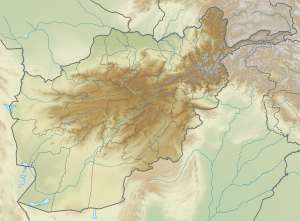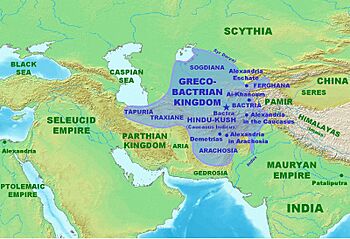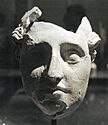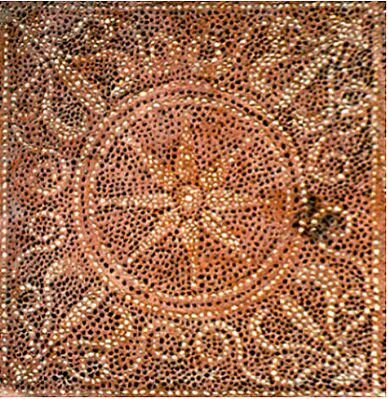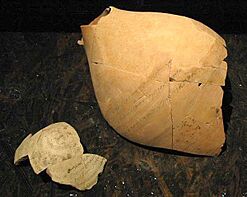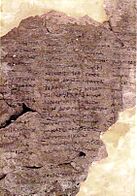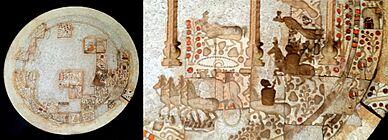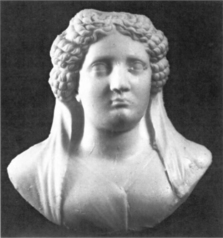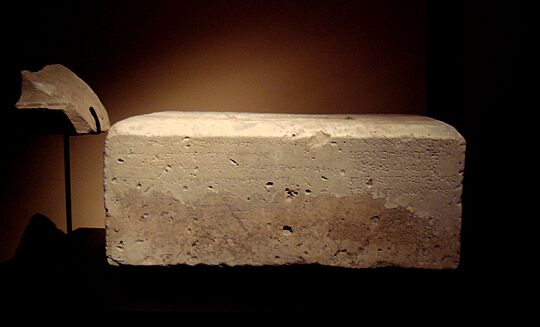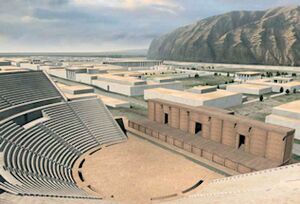Ai-Khanoum facts for kids
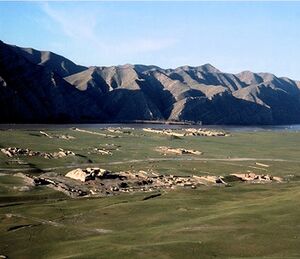
The primary sanctuary of Ai-Khanoum, as viewed from the acropolis in the late 1970s.
|
|
| Location | Takhar Province, Afghanistan |
|---|---|
| Region | Bactria |
| Coordinates | 37°09′53″N 69°24′31″E / 37.16472°N 69.40861°E |
| History | |
| Founded | 3rd century BC |
| Abandoned | 145 BC – 2nd century BC |
| Periods | Hellenistic |
| Site notes | |
| Excavation dates | Between 1964 and 1978 |
| Archaeologists | Paul Bernard |
| Condition | Ruined since antiquity; also plundered by modern looters. |
Ai-Khanoum (meaning Lady Moon) is an ancient city in Takhar Province, Afghanistan. It was a major city of the Hellenistic period, a time when Greek culture spread far and wide. The city was likely started by the Seleucid Empire, a powerful kingdom that came after Alexander the Great.
Ai-Khanoum was an important military and trading hub for the Greco-Bactrian Kingdom. This kingdom was ruled by Greek kings in Central Asia. The city thrived until it was destroyed around 145 BC. It was rediscovered in 1961 and explored by French archaeologists. However, their work stopped in the late 1970s due to conflict in Afghanistan.
The city was probably founded between 300 and 285 BC. It was built by an official working for Seleucus I Nicator or his son Antiochus I Soter. These were the first two rulers of the Seleucid dynasty. Some people thought Alexander the Great founded it, but this is now unlikely.
Ai-Khanoum was located where the Amu Darya (also called Oxus) and Kokcha rivers meet. This area had good farmland for growing crops. The city had a lower town and a high acropolis (a fortified hilltop). Even though it wasn't on a main trade route, Ai-Khanoum controlled access to important mines and mountain passes. Strong walls protected the city, and they were always being improved.
The city grew thanks to royal support and having its own mint (a place where coins are made). But it lost some importance when the Greco-Bactrians broke away from the Seleucid Empire around 250 BC. Ai-Khanoum then became more of a military base. It might have been a battle zone during an invasion by Antiochus III the Great around 209-205 BC.
The city started to grow again under kings Euthydemus I and Demetrius I of Bactria. Many of the ruins you see today are from the time of Eucratides I. He rebuilt much of the city and might have even renamed it Eucratideia after himself. Soon after his death around 145 BC, the Greco-Bactrian kingdom fell apart. Ai-Khanoum was captured by Saka invaders and mostly abandoned.
In 1961, the King of Afghanistan, Mohammed Zahir Shah, found the city again during a hunting trip. A team of archaeologists, led by Paul Bernard, began digging. They found a huge palace, a large gymnasium, a theatre for 6,000 people, an arsenal, and two temples. They also found inscriptions, coins, and pottery. Sadly, the Soviet-Afghan War in the late 1970s stopped the work. During later conflicts, the site was heavily looted.
Exploring Ai-Khanoum
How the City Was Built
Ai-Khanoum was built in a strategic spot in the Bactria region. It was at the meeting point of the Oxus and Kokcha rivers. This area had fertile soil for farming and nearby mountains for grazing animals. The region was also rich in minerals like lapis lazuli, copper, iron, and rubies.
The city's location helped protect it. The Kokcha and Oxus rivers had steep cliffs, making it hard for enemies to attack from the water. To the east, a natural acropolis, about 60 meters (200 feet) high, provided a strong defense. This plateau also had a small citadel, like a mini-fort, at its southeast corner.
These natural defenses were made even stronger with walls that surrounded the entire city and acropolis. The northern walls were especially strong, as there were no natural barriers there. They were 10 meters (33 feet) high and 6 meters (20 feet) thick, made of solid mud bricks. They also had large towers and a deep ditch. These huge walls meant that a small number of defenders could hold off a large attacking army.
The main gate was in the northern wall. From there, a straight street ran south along the base of the acropolis, through the lower city, to the river. This street was about 1.5 kilometers (1 mile) long. Most of the lower town was not planned in a grid, which was different from other Greek cities of the time. Ai-Khanoum was mainly built using unbaked bricks, with baked bricks and stone used less often.
The Grand Palace
The palace complex was huge, covering about a third of the lower town. It was built by King Eucratides I to show his power and wealth. It served as a government building, a home for the king, and a place to store treasures. A massive open area, about 27,000 square meters (6.7 acres), was south of the palace. It might have been used for military parades or drills.
You entered the palace through a grand gateway called the Main Propylaea. This gateway led to a curved road that went to the palace's main courtyard. This rectangular courtyard was surrounded by 118 Corinthian columns. The columns on one side were nearly 10 meters (33 feet) tall!
Inside the palace, there was a large reception room decorated with wooden lights, painted lion heads, and geometric art. This room connected to other parts of the palace. The palace was divided into three main areas, each with a different purpose. These areas were linked by courtyards and long hallways, designed for both privacy and easy access for the royal family and important officials.
The Treasury
The treasury building was on the western side of the palace courtyard. It had 21 rooms grouped around a square courtyard. This building stored the palace's valuables in vases labeled in Greek. These items included gemstones, lapis lazuli from nearby mines, ivory, olive oil, incense, and money.
Many of the vase labels described money transactions. For example, one label said an official named Zenon transferred 500 drachmas to two employees. Other vases held luxury goods like incense from the Middle East or olive oil from the Mediterranean. Some items in the treasury were likely treasures brought back by King Eucratides from his campaigns in India. These included Indian agates, jewelry, and a disc made of mother-of-pearl showing a scene from Hindu mythology.
A small library was also found near the treasury. Archaeologists discovered fragments of two ancient texts there. One was a Greek tragedy (a play) and the other was a Socratic dialogue (a philosophical discussion), possibly by Plato or Aristotle. This shows that the people of Ai-Khanoum were interested in learning and philosophy.
Homes in the City
South of the palace, there was a residential area with rows of large, fancy houses. These houses were separated by streets that crossed at right angles to the main road. Archaeologists excavated one house that was 66 by 35 meters (217 by 115 feet). It had a large courtyard and a main building with a central reception room, a bath, and a kitchen.
Another house, located just outside the northern wall, was even larger, covering 108 by 72 meters (354 by 236 feet). It had a similar layout to the houses inside the city, with a large courtyard and living quarters. These large homes were different from traditional Greek houses, suggesting they were influenced by Iranian architecture. The city also had smaller houses for people of lower status.
Religious Buildings
Archaeologists found three temples at Ai-Khanoum. One large temple, called the Temple with Indented Niches, was in the lower city near the palace. It was built on a 1.5-meter (5-foot) high platform. Its walls were 6 meters (20 feet) high and had unique "indented niches." This temple combined Greek and Persian architectural styles.
Many artifacts were found at the temple, including special cups for offerings, ivory furniture, and a unique medallion. This silver disc shows the Greek goddess Cybele with Nike in a chariot pulled by lions. It's special because it mixes Greek and Eastern art styles.
A statue of a god, probably Zeus, stood in the center of the temple. Only a small part of its foot survived, showing a thunderbolt, a symbol of Zeus. This mix of a Greek statue in an Eastern-style temple suggests that Greek and Bactrian religions blended together here.
The Hero's Shrine of Kineas
One of the most important discoveries was a small shrine called a heroön, located north of the palace. It was built on a three-stepped platform. Underneath, archaeologists found four coffins. In ancient Greek cities, burials were usually outside the city walls. But special exceptions were made for important citizens, especially city founders.
The earliest and most prominent coffin was linked to the temple above by an opening. Offerings could be poured down this opening. This suggests the coffin held the remains of a very important person, likely the city's founder or an early leader named Kineas.
Archaeologists also found the base of a stone slab, called a stele, in the shrine. It had the last five lines of wise sayings from the Temple of Apollo in Delphi, Greece. Next to these sayings was a poem honoring a man named Klearchos. He had copied these sayings from Delphi and brought them to Ai-Khanoum. This shows a strong connection between this distant city and the heart of Greek culture.
The poem on the stele is beautifully written, like famous Greek works such as Homer's Odyssey. Historians believe this stele was placed by the first generation of Greeks born in Bactria. They wanted to show that Ai-Khanoum was a true part of the Greek world. Some even think it might have influenced the Buddhist Edicts of Ashoka, showing how Greek ideas could have spread to India.
Other Important Buildings
A large gymnasium was located along the western walls. It was a place for exercise and learning, like a school. It had a southern courtyard and a northern complex with long rooms around a central square courtyard. Inside, a small platform held a statue and an inscription dedicated to Hermes and Heracles, the patron gods of Greek gymnasiums.
The arsenal, where weapons were stored and made, was on the eastern side of the main street. Blacksmith workshops were likely here, as lots of metal waste was found. Few weapons were recovered, suggesting the army was away when the city was attacked. The weapons found included arrowheads, spears, javelins, and even early iron cataphract (heavy cavalry) armour.
The theatre was built into the side of the acropolis. It could hold between five and six thousand spectators, which was more than the city's population. This means people from the surrounding areas probably came to watch plays or religious festivals. Sadly, the bones of about 120 people were found in the orchestra (the central part of the theatre), likely from when the city fell in 145 BC.
What We Learned from Ai-Khanoum
Ancient Coins
| Greco-Bactrian kings | Hoard #1 (1970) |
Hoard #2 (1973) |
Hoard #3 (1973/4) |
Stray coins |
|---|---|---|---|---|
| Diodotus I | 0 | 8 | 11 | 26 |
| Euthydemus I | 0 | 27 | 81 | 49 |
| Demetrius I | 0 | 3 | 8 | 0 |
| Euthydemus II | 0 | 1 | 3 | 0 |
| Agathocles | 683 | 3 | 6 | 0 |
| Antimachus I | 0 | 2 | 2 | 0 |
| Apollodotus I | 0 | 1 | 2 | 0 |
| Eucratides I | 0 | 1 | 9 | 12 |
Archaeologists found three groups of ancient Greek coins, plus many single coins, at Ai-Khanoum. One group found in the palace contained 677 coins and six silver coins of Agathocles of Bactria. These six coins are very special because they have both Greek and Brahmi (an ancient Indian script) writing. They also show some of the earliest clear images of Hindu gods.
These coins show that the worship of these Hindu gods had spread far from India. They also suggest that these gods were important enough to be featured on royal coins. Another group of coins was found in a house outside the city walls. Most of these were Greco-Bactrian coins, mainly from King Euthydemus I.
One series of coins from the time of Antiochus I had a special triangular mark. Bricks with the same mark were found in the hero's shrine of Kineas, one of the oldest buildings in the city. This suggests that Ai-Khanoum was the main place where Seleucid coins were made during Antiochus's early rule.
Greek Influence in Asia
Some items found at Ai-Khanoum, like Greek olive oil, suggest there were large trade networks. However, such findings are rare. This means that the Greco-Bactrian kingdom might have been somewhat isolated in terms of trade. But it had a well-organized government and a diverse economy. This system later influenced other nations in the region, like the Yuezhi and Kushan, who used Greek titles and coin styles.
Historians also believe that Ai-Khanoum might have helped spread Greek art to ancient India. For example, the sculptures on the pillars of Ashoka in India might have been inspired by drawings of Greek buildings from Ai-Khanoum. The art found at Ai-Khanoum itself is very creative. It includes the largest Egyptian faience sculpture found in the Greek world, which mixed Eastern techniques with Greek traditions. A small statue of Heracles found at the site also shows how Greek art continued to influence later Indo-Greek coins.
Why Ai-Khanoum Matters Today
The discovery of Ai-Khanoum was incredibly important for understanding the Greco-Bactrian kingdom. Before this find, archaeologists had struggled to find physical proof of Greek culture in Central Asia. They only had old texts and a few coins. One famous archaeologist, Alfred Foucher, even called the idea of Greek culture in Bactria a "mirage" because he couldn't find anything.
But Ai-Khanoum changed everything! Its discovery brought new energy to the study of this region. Since then, several other Greek sites have been found across Central Asia. Ai-Khanoum truly marked a turning point in understanding the distant Greek world.
Images for kids
-
Migrations of the Yuezhi tribes in the last two centuries BC
-
King Mohammed Zahir Shah (right) in 1963, two years after his rediscovery of Ai-Khanoum, in the company of US President John F. Kennedy
See Also
- Hellenistic influence on Indian art



